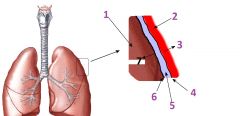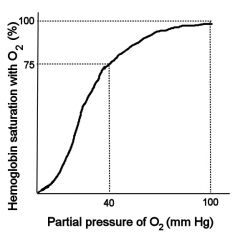![]()
![]()
![]()
Use LEFT and RIGHT arrow keys to navigate between flashcards;
Use UP and DOWN arrow keys to flip the card;
H to show hint;
A reads text to speech;
26 Cards in this Set
- Front
- Back
|
What is the purpose of the respiratory system?
|
Supply O2 for the ETC and remove CO2 that is produced in pyruvate decarboxylation and the Krebs Cycle
|
|
|
What do the type I alveolar cells do?
|
Allow exchange of CO2 and O2
|
|
|
What do the type II alveloar cells do?
|
Produce surfactant which reduced the surface tension of water
|
|
|
What do macrophages do in the alveloi?
|
Ingest and destroy foreign material
|
|
|
What is Dalton's Law?
|
total pressure of a mix of gasses is the sum of the partial pressures of the constituent gases.
|
|
|
What is Boyle's Law? How does it relate to inhalation and exhalation?
|
P1V1= P2V2
For inhalation: volume of the lungs increases causing the pressure to decrease For exhalation: The volume of the lungs decreases, causing the pressure to increase |
|
|
What does Henry's Law have to do with the pulmonary system?
|
CO2 is more soluable that O2 in water which lead to the evolution of respiratory pigments, such as hemoglobin, that greatly increase the soluability of O2 in blood.
|
|

Name the structures of the pleural sacs
|
1. Lung
2. Chest wall 3. Elastic recoil 4. parietal pleura 5. Pleural fluid 6. visceral pleura 7. elastic recoil |
|
|
during quiet breathing what structures are used in inhalation and expiration?
|
Inhalation: Diaphragm and external intercostals (contract)
Expiration: Diaphragm and external intercostals (relax) |
|
|
During active breathing what structures are used during inspiration and expiration?
|
Inspiration: diaphragm and external intercostals contract, along with neck muscles
Expiration: Internal intercostals and abdominal muscles contract and diaphragm and external intercostals relax |
|
|
What is a pneumothroax?
|
Collapsed lung
|
|
|
What is LaPlace's Law and how does it pertain to in the pulmonary system?
|
P= 2T/ r
describes the air pressure inside of the alveolus |
|
|
how does LaPlace's Law affect alveoli of different sizes?
|
Because smaller alveoli are harder to inflate a greater amount of surfactant is made in the Type II cells of the small alveoli
|
|
|
What is the average residual volume for a male?
|
1200 ml
|
|
|
What is the average Expiratory reserve volume for a male?
|
1100 ml
|
|
|
What is the average tidal volume for a male?
|
500 ml
|
|
|
What is the average inpiratory reserve volume?
|
3000 ml
|
|

Describe the steps for tidal volume exchange
|

|
|
|
How do you calculate the total ventialtion per minute?
|
Total= TV * RR
|
|

Describe the pressures for gas exchange
|

|
|
|
What is the partial pressure of O2 when hemoglobin is 98% saturated?
|
100 mm Hg
|
|
|
What is the partial pressure of O2 when hemoglobin is 75% saturated?
|
40 mm Hg
|
|

What would cause the O2 binding curve to shift to the right? What would the consequences be?
|
Causes: Higher levels of 2.3-BPG, decreased pH, and increased temperature
Consequences: Decreased affinity, resulting in less oxygen loading in pulmonary capillaries and more unloading in systemic capillaries |
|

What would cause the O2 binding curve to shift to the left and what would the consequences be?
|
Causes: Lower levels of 2,3-BPG, increasing pH, decreased temperature
Consequences: Increased affinity resulting in more oxygen loading in pulmonary capillaries and less unloading in systemic capillaries |
|
|
The O2 binding curve for a fetus is shifted to the left compared to the maternal curve, what does this cause?
|
Fetal hemoglobin is more saturated than maternal hemoglobin at a given partial pressure, permits the fetus to survive in the hypoxic environment of the uterus
|
|

Describe CO2 diffusion in and out of the blood
|

|

